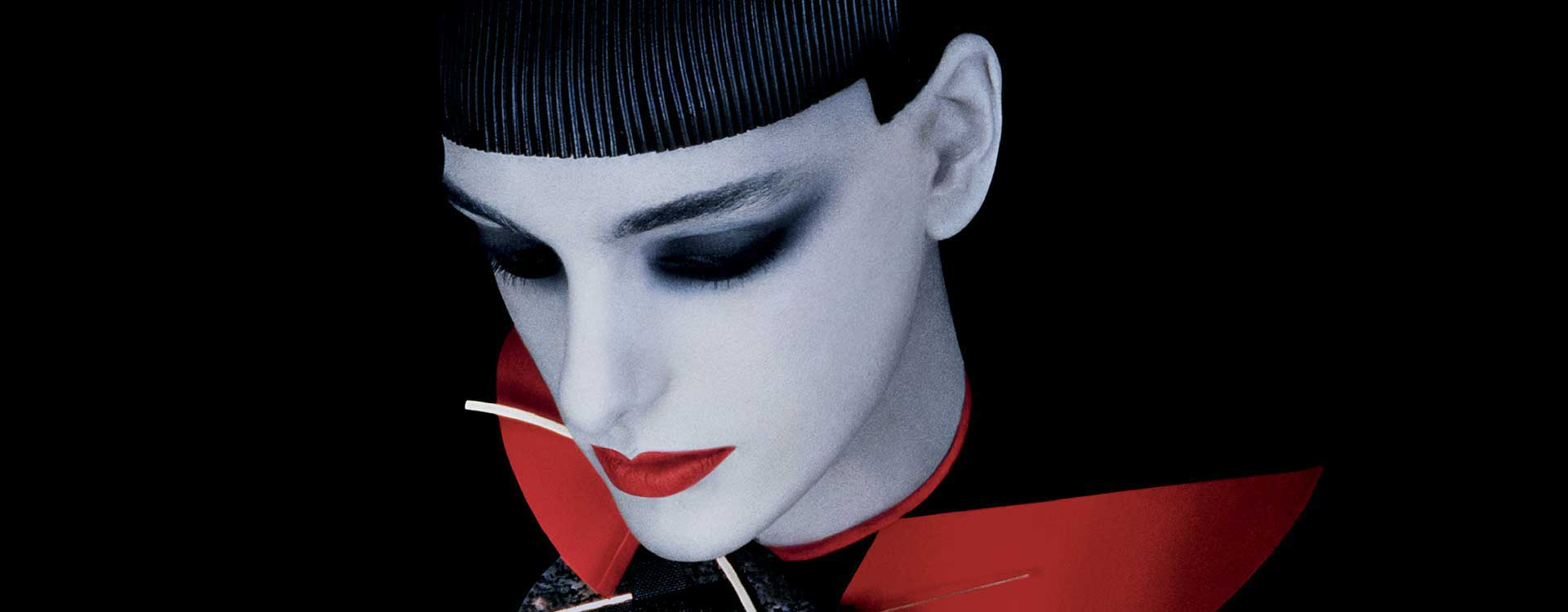Serge Lutens
I grew up among the women of Serge Lutens: these slightly worrying pallid faces embodied another femininity. Squeezed between Cindy Crawford’s mane and the women shot by Peter Lindbergh for Comme des Garçons, the dramatic icons featured on Shiseido ads seemed out of place.
Later, around the opening of the Palais Royal store, I would religiously collect the concrete testers of fragrances with enigmatic names that were sent out to get us intrigued.
On November 18th, in a Parisian gallery, I met with Serge Lutens for a conversation replete with digressions on his double, the importance of faith and that of finding your own marble.
What does the idea of Transformation mean to you?
Transformation – in other words the transition to otherness; I am two-fold. Double-ness as the choice of a child, a choice made before the age of 7. The choice was feminine. If there’s no way for me to make this double come out in some way, I croak. Period.
Why make-up?
Make-up is my way of splitting in two. I’m not looking for a physical type, a human reality that would supposedly represent me.
I see myself in many things by both choice and taste, but in the feminine element rather than the masculine.
That’s something I no longer want to do; these days I devote myself to writing.
What were the photo shoots like?
Anytime a model arrived at the studio, I had picked her because of the characteristics of her features and curves. A selection based on what I see as beauty: that which you can’t define but which you’re attracted to.
If you define beauty, then you betray it – it is screwed.
It’s not her, by the way, it’s me. I cross to the other side. And make-up is your ticket to the other side – that step towards the other, but the other me.
I always started by painting her white. Whiteness has 2 meanings: erasing in order to write oneself, erasing her whilst retaining her so as to write myself. Writing out this idea of a woman, my other self.
This caused quite a scandal in 1968 for Christian Dior. These very white women offended; perfume stores wouldn’t hear of them.
I like this quote by Michelangelo about his own work, which I can take up in a slightly different way: “When will I be done with this marble, which prevents me from completing my statue?” When will I be done with this woman, who prevents me from getting to myself. It’s about meeting yourself and that’s the idea of beauty. How do you cross to the other side?
What’s your own marble? You need to get to the other side, the ideal you, the dreamed you. Maybe we’re transparent; we’re looking for something in which we can materialize.
I’ve read that you only knew how to do something if you wanted to do it.
I’m entirely self-taught. I did things out of necessity. This wanting-to-do was so strong, so imperious, that I knew and learned. Those labels, “the greatest make-up artist in the world”… that makes no sense. Life puts you on a pair of rails, there’s nothing you can do about it. Call it fate. Even if you don’t believe in it, that’s what it is.
What about your relationship with the beauty industry?
There was such faith in me. In every sense of the phrase I was crossing to the other side.
I’m a man of faith – if I believe in something then it goes alright. A firm conviction is a religious thing. Working for Dior, for Shiseido… that’s still me, I wouldn’t know how to do it in any other way.

And your collaboration with Dior?
Dior only had nail-polishes and lipsticks. They were very famous, had a durable quality. Dior wanted to launch their make-up line, and I upended the whole thing through colors. Everyone looked at me funny, but I also had supporters. Some people get it, people who believe in themselves through what you do.
And industrials only see one thing, and that’s success.
In 1968 we launched the Dior make-up line just before the events of that May.
Yellows, reds for the eyes, improbable colors applied on thoroughly white women. It met with unbelievable success.
Women were not buying make-up: they were buying freedom, and most importantly, audacity.
That revolt took on this particular form: make-up. In the eye-shadow cases, there were 3 colors: only one of them was worn out; the other 2 were not being used. But it was the other 2 that sold the one in the middle – an intricate game of contrasts, of colors and audacity. Once again it was about syntax – how they were arranged, how you made them speak. Success was such that to this day the Dior make-up brand is still informed by what I did then.
How did you go about inventing these colors?
I had never dealt with colors my whole life. Monsieur René Bourdon, my contact at Dior, told me there’s nothing to it: we’ll give you some bowls and some pastes and you’ll make the colors as you like them. I mixed. I could not go to the Laboratory, the very word scared me, I was going to be surrounded by scientists telling me don’t do this don’t do that. I could see a nightmare on the horizon.
I created the colors in my kitchen for 13 years.
There’s nothing you need to learn. Know what you like, and see how it turns out.
I invented transparent colors for the lips – nobody was doing that. At Dior they were all shocked, and those colors didn’t go any farther than tests in the lab. Then Estée Lauder launched transparent glosses just like my tests and I became a genius. That’s how I became a genius (laughs) I wish I’d had them out on the market earlier, but even though they were ready they only came out later.
And so you became “the greatest make-up artist in the world”?
Everything changed after that success; I unshackled color, which had hitherto been immobilized. Color ventured away from the eyelids. Color was free. It had a liberating meaning.
Diana Vreeland said about Vogue, it’s the reality of a myth, that is to say fashion – and I, I was the reality of beauty, that is to say the impossible. Make-up became a sort of soul. No longer just a tool to make your eyes wider, it took on a certain grandeur.
How did you learn?
These very white make-ups I first tried on some of my female friends. I mimed them to myself. Very white, with shaded eyes, powdered lips, straight hair.
I would feel these things – it’s very strong, it’s light.
My first pictures date back to 1967 and I learned on my own because it felt like a necessity. There’s no school, it’s the school of faith. These are jobs, but to me that’s not what they were.
You either believe in it or you don’t.
The first order of business was not to put myself in the service of make-up, I didn’t give a fuck about that. Same thing for photography. The tool gets invented. It never stays the same. The violence you have in you, you’re going to transfer it. When you’re feeling in the dumps, you’re going to transfer it.
It’s not about make-up – just like perfume, I don’t give a fuck about that – it’s about what needs to be told and shown.
Your pictures for Shiseido left a mark on a generation?
I’m 72 and these images left a mark on the collective subconscious of two or three generations. It’s crazy, because these images did not merely have an impact on consumption, even though they did that. Otherwise I wouldn’t be here today. Several of my films in Japan have had a lasting impact on girls.
Creating is stepping into the religious – that which links, which binds. What we call a creator is someone who, through his or her sensitivity, through some sort of wound, something difficult, can tap into a more universal language. He’s ahead, but not entirely on the outside.
But this being ahead is radical; you have no idea how they looked at me when I barged into this whole thing.
How was the world of Beauty when you first started?
A girl photographed before and after always looked better before. They told you that with a jaw like this, you needed to put some brown blush here. Some sort of topsy-turvy geometry. The texts in the magazines were ridiculous: “Surprise your husband”. He would be surprised alright! Their rules could look good on Lisa Fonssagrives, they could be sublime on sublime girls. Trying this in real life was absurd; it made no sense. It got people stuck within an image. Today it’s the same thing all over again and in fact they’re wordlessly telling you that you’re ugly.
The new icons are prisons for the self; they are not liberating; on the contrary they’re shackles and chains. Men have a tremendous influence on the idea of beauty, they turn it into something that’s either prudish or designed to excite them. Here’s another recipe for beauty: men living with women and ridding them of their complexes.
What about your launching Mine de Rien? Does it betray a desire to do make-up again?
Quitting make-up was my reaction to what was happening in stores: the cartloads of testers, the tons of lipstick and foundation…
I adapted beauty to how I personally felt it – i.e. something minimal. I called that le nécessaire de beauté, “beauty essentials”, a form of politeness.
It’s no longer something that is offered to you, that speaks to you, but to thousands of women who must find something they like.
When I go shopping in Morocco, I wander through the perfume stores. Who is this all for? Make-up no longer serves its purpose; it no longer brings anything.
And what about perfume?
I’m not interested in perfume as a product. What’s interesting is what I bring into it. A grounding experience; becoming one again. I know where I want to get to, where I need to go, and I know it’s there. I wouldn’t say there’s pleasure in making it – no, it’s work, and relentless at that. A crazy amount of work – finding exactly. The real partner is the perfume.








laissez un commentaire
Connectez-vous pour poster des commentaires